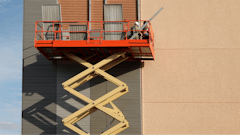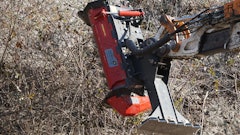Having the right mix of concrete equipment is like walking a tightrope - if you don't have the pieces your customers need, you lose business; if you have pieces your customers don't rent, you lose money. Although it's a delicate balancing act, it is possible to create the right mix of concrete equipment to satisfy your customer base.
As with any type of equipment, you'll need to take the pulse of your rental business and understand a few key points - like your customers and your market - in order to get the mix of equipment right.
Know your customer: If your typical customer tends to be the weekend warrior or small contractor, a 12-cubic-foot concrete mixer will not be highly utilized. Who your customers are will tell you a lot about the type of jobs they'll be tackling and what type of equipment they'll need to get it done.
Know your market: Try to keep tabs on construction projects in your area. Are most jobs small housing projects or are they high-rise, institutional buildings" This will not only help you stock the right type of equipment, but also the right size. DIYers will need smaller mixers, for example, than a contractor pouring a large slab.
Understanding your customers' needs and your market is the first step. Knowing the different types of concrete working equipment is the next.
The basics
Becoming a "concrete equipment supplier" is much more than having a few trowels and mixers. For example, compressors run the breakers that break out the old concrete, mixers make new concrete, saws cut it, power buggies or pumps place the concrete, and screeds, floats and trowels finish it.
Because each rental business is different, there cannot be one all-inclusive list that is right for everyone. There are as many right combinations of equipment as there are rental businesses. There are a few basic pieces of concrete equipment that every rental business should stock, however.
- Electric breakers remove old material, including sidewalks, stones, brickwork, asphalt, etc.
- Mixers mix concrete, mortar, grout, plaster and more. A concrete mixer will mix mortar or plaster, but a mortar mixer will not mix concrete. Several mortar mixers, including 6-, 8-, 9- and 12-cubic-foot sizes, and several concrete mixers, 6- and 9-cubic-foot for contractors and a 2-cubic-foot for homeowners, is suggested.
- Buggies move concrete and mortar and aid in filling forms. They can also be used to move debris and dirt.
- Vibrators consolidate concrete (remove air bubbles) to make the concrete stronger. A unit with two size heads and shafts can get you started. "A rental business can begin with a general purpose vibrator that incorporates the most popular size motor shaft and head," says Fred Oswald, president of Oztec Industries. Oztec units come equipped with a Quick Change system to allow the shaft and head to couple to the motor in seconds without any tools. "This allows rental stores to mix and match shafts and heads on the motors to meet their customers' needs," says Oswald. "The rental company can then add to its vibrator rental line according to what their customer's needs are."
- Screeds. Wet screeds flatten and consolidate concrete and can be used in residential, light commercial, industrial and highway applications. "Most homeowners will not want to buy and will readily rent a wet screed with at least two size boards and hand tools," says Jim Lewis, national product specialist, Wacker Neuson. Truss screeds flatten and consolidate concrete in larger areas. These units are used on larger pours and can be used on surfaces up to 8 inches thick where critical flatness is necessary.
- Power trowels are used for both floating and finishing large slabs. Compared to ordinary hand tools, power trowels significantly increase production and reduce costs by their ability to cover more square footage of the slab per day. Walk-behind trowels are available in 24-, 30-, 36-and 48-inch blade diameters. To get started, a 24- and 36-inch unit is advised. "Ordinarily, hand tools might finish 300 to 600 square feet per day whereas a 36-inch walk-behind trowel can finish 700 to 1,500 square feet per day depending on job circumstances and weather," says Lewis. "Ride-on trowels are typically available with two rotors in 36- or 48-inch models and can dramatically increase production. Depending on the job site conditions and operator proficiency, one ride-on model can replace three to four walk-behind units."
- Concrete saws cut expansion joints in flat work and can also be used for demolition of existing concrete slabs. They're designed to cut concrete, brick, stone, asphalt, steel and more.
- Basic concrete hand tools and bull floats.
How many of each type of concrete equipment should you stock? "Rental businesses should really have at least two of each size because the worst thing they can do is not have the product in inventory available to rent," says Rob Newell, domestic sales manager, Stone Construction Equipment. "Typically, if a contractor or even a DIYer is looking to rent equipment, they need it immediately. It isn't going to be something they can wait weeks or months for until the store gets it in stock.
"It's always a good idea to have a least one representative model in inventory in the showroom at all times," he continues. "This allows employees to show anyone who walks in what equipment they carry. If the showroom inventory is limited, it might indicate the available equipment for rent is as well."
Beyond the basics
"The basic list above can get the rental center operator started," says Lewis with Wacker Neuson. "As they build their concrete contractor customer base, they will be able to tailor their line to meet the needs of their customers. Having the right machines and accessories in stock can make or break the rental."
For example, with mixers, a professional masonry contractor is going to have different needs that your typical DIYer.
"A mason is going to prefer using a mortar mixer, whereas a contractor doing flat work or pouring foundations, deck supports, etc., would use a concrete mixer," says Newell with Stone. "A homeowner is going to need a smaller mixer, like a 2-cubic-foot unit."
If your rental business is just getting started in the concrete equipment business, sources say your should start out small and work your way up as your customer base dictates. If you've decided your market can support a "concrete specialty rental house," you'll need to target the large foundation and flat work contractors in the area, says Ben Wiese, product manager with Multiquip.
"This market segment will rent equipment when their equipment needs maintenance," he says. "The rental store's ability to react is paramount for these types of rentals."
Just as important as the type of equipment in stock is having an employee designated as a concrete specialist to answer questions and give training when necessary, says Wiese.
"This market segment will bring many rental opportunities," he says. "But it also brings the added need of large pour support and all the consumables this represents."
Whether you're just thinking about adding a small line of concrete equipment, or you're ready to jump to the next level and become a "concrete specialist," the best way to get the right mix of equipment is to talk to your customers to fulfill their needs.



























